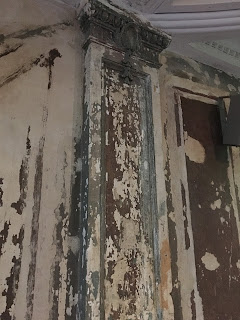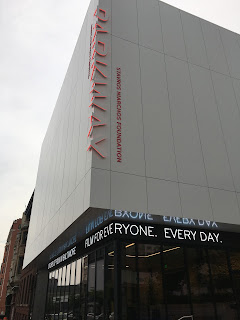The Parkway was built in 1915 in the Italian Renaissance style by architect John Eberson; it was redecorated in 1926 and remained open until 1977 when it closed due to declining attendance and urban decline. (Maryland Historical Society Library).
 |
| The lobby of the renovated Parkway at the soft opening for funders (Photo: Philipsen) |
The renovated Parkway is more than another art-house movie in Baltimore and it is more than another renovated building in Station North. The Parkway will not only anchor Maryland's Film Festival with its own place allowing film presentations year around, it will also further cement Baltimore as a destination for film aficionados, those who want to watch cinema and those who want to make cinema.
 |
| Marchand-Meffre photo of the Parkway (2014) |
Filmmaker Matt Porterfield put the advantage of a permanently available big screen most succinctly when he spoke on Tom Hall's Midday Friday which was broadcast from the Parkway. "Watching a film on a laptop compared to in the cinema", he said " is like the difference between drinking a Bud Light and tripping on mushrooms". Program Director Roberto Busó-García who runs Johns Hopkins' graduate film program in the nearby Center Theater, also in Station North, put it a bit more subtly:
There is an authority in the big screen that no other screen has. A power from bringing people together in a dark room. (R. Buso-Garcia)He said the Jed Dietz' Maryland Film Festival "opens the world to our students".
Elissa Blount Moorhead, the executive director of the Station North Arts and Entertainment District who has her own film company in NY, Mater Mea, spoke about the Parkway as a place of
"cultural reference to the cultural history of Baltimore" and the ability to "map identity to the work : that is coming out of here". She said "this can become a space of equity if we do the right thing" and mentioned Frederick Douglas who "was one of the most photographed men of his time". She pointed out that story-telling and image-making combined is what we talk about when mapping cultural identity.
 |
| The renovated Parkway with its new addition which houses and event space and two black box theaters (photo: Philipsen) |
The renovation of the Parkway followed four rules, according to architect Steve Ziger who also designed the Centre Theater renovation. "Films are storytelling: we wanted the building to tell the story", Ziger said "if it was there and in good shape, we left it, if it was in bad shape we repaired it, if it was missing we left it missing, everything new was decidedly new". Tom Hall asked from several e-mails coming from the audience: "is it finished yet"? The rawness of old structures maintains the somewhat morbid ruin-chic that already attracted Marchand and Meffre and sits just fine with the folks from the Historic Trust. No better way to maintain history and tell its story. Ziger-Sneads website explains it this way:
Film making is about storytelling. Inspired by many layered stories of the historic Parkway Theater, the design curates an unparalleled movie-going experience.
The new SNF Parkway stands as a physical record of the technical and cultural evolution of film from its earliest days to today. The design approach celebrates the accumulated layers of each movie era with intentional contrast to modern interventions. The result is an authentic, rich, vibrant “rescued ruin” that energizes the film complex and anchors its critical location in the heart of the Station North Arts District..
Asked whether the Parkway wouldn't undermine Buzz Kusack's Chrales and senator Theaters, both art house movie theaters catering to movie lovers, Jed Dietz of the MdFF responded that the New York Times movie reviews include over 950 films a year and that only 350 were shown in Baltimore, presumably leaving lots to show in the Parkway, provided aficionados have enough time to watch it all.
The Parkway, programmed by Jed Dietz , can become proof for the idea that urban development, culture and identity are not zero-sum games but require critical mass. The Station North A&E District is well underway to achieve enough momentum to become a national draw for artists and especially those interest in film. If done right, the Charles Theater around the corner will benefit as well.
 |
| The completed theater still boasts a "ruin" look (Photo: Philipsen) |
The Parkway, programmed by Jed Dietz , can become proof for the idea that urban development, culture and identity are not zero-sum games but require critical mass. The Station North A&E District is well underway to achieve enough momentum to become a national draw for artists and especially those interest in film. If done right, the Charles Theater around the corner will benefit as well.
Previous article about the Parkway on this Blog
Links:
BmoreArt (images: Cara Ober)
Marchand-Meffre and Theater Photography
Pictures gallery:
 |
| Charles Street facade propped up during construction for the new addition (Photo: Philipsen) |
 |
| The Parkway, abandoned with the last curtain still hanging Photo: Cara Ober, Bmore Art) |
 |
| The Parkway and the chicken mural behind which the Station North A&E had its headquarters for a while Photo: Cara Ober, Bmore Art) |
 |
| The center of the dome over Parkway after the renovation (photo: Klaus Philipsen) |
 |
| Midday Panel with (from right) host Tom Hall, Jed Dietz, Anna Hornaday and Steve Ziger (Photo: Philipsen) |
 |
| Midday: Jed Dietz discusses films with Elissa Blount Moorhead and Roberto Busó-García (Photo: Philipsen) |
 |
| The ruin look in detail (Photo: Philipsen) |
 |
| Coming soon posters are up to date again (Photo: Philipsen) |
 |
| The new addition at the corner of Charles and North (Photo: Philipsen) |
 |
| The balcony level tea room overlooking North Avenue today (Photo: Philipsen) |
 |
| The tea room before the renovation (Photo: Cara Ober, Bmore Art) |
My book, Baltimore: Reinventing an Industrial Legacy City is my take on the post industrial American city and Baltimore after the unrest.
The book is now for sale and can currently be ordered online directly from the publisher with free shipping.

No comments:
Post a Comment